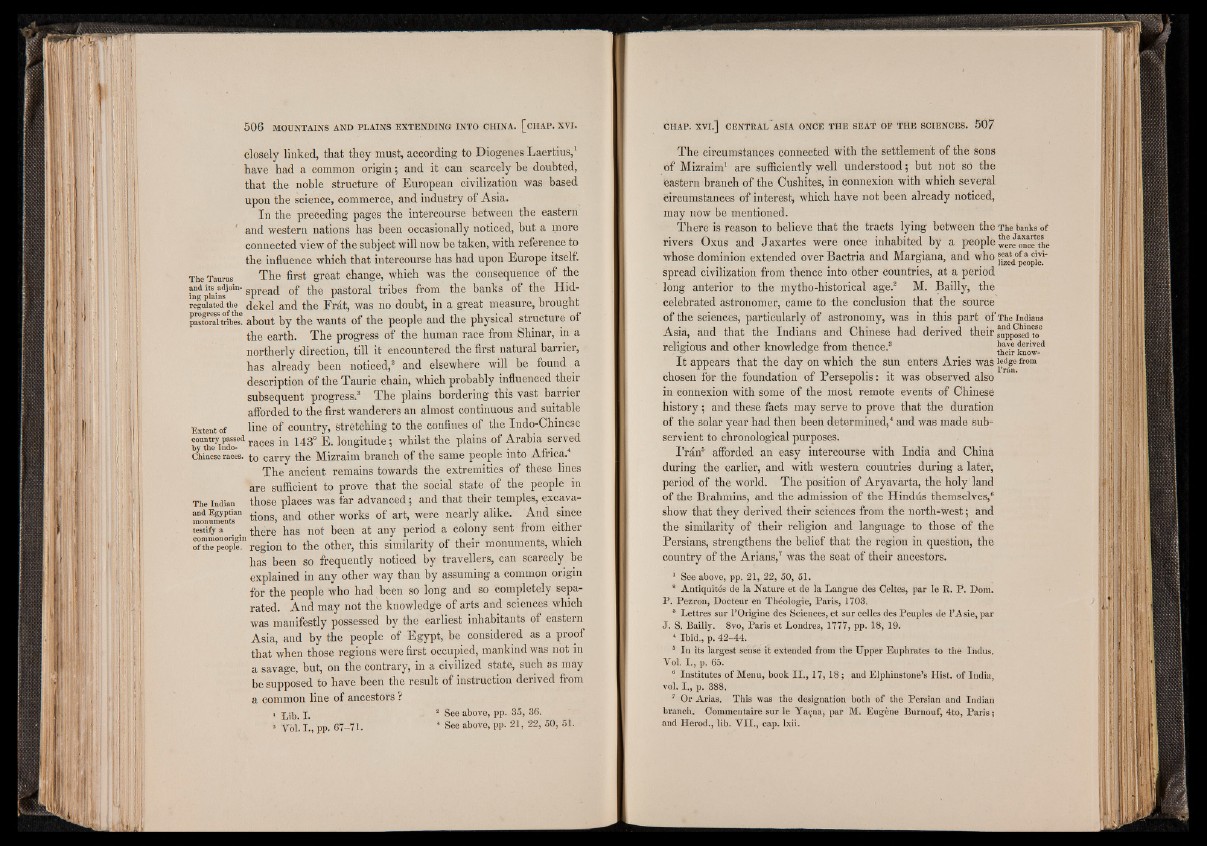
closely linked, that they must, according to Diogenes Laertius,1
have had a common origin; and it can scarcely be doubted,
that the noble structure of European civilization was based
upon the science, commerce, and industry of Asia.
In the preceding pages the intercourse between the eastern
and western nations has been occasionally noticed, but a more
connected view of the subject will now be taken, with reference to
the influence which that intercourse has had upon Europe itself.
The Taurus The first great change, which was the consequence of the
and its adjoin- r d. of the pastoral tribes from the banks of the Hid- mg plains r r 4
regulated the dekel and the Frat, was no doubt, in a great measure, brought
pastoral tribes, about by the wants of the people and the physical structure of
the earth. The progress of the human race from Shinar, in a
northerly direction, till it encountered the first natural barrier,
has already been noticed,2 and elsewhere will be found a
description of the Tauric chain, which probably influenced their
subsequent progress.3 The plains bordering this vast barrier
afforded to the first wanderers aii almost continuous and suitable
Extent of line of country, stretching to the confines of the Indo-Chinese
country passed in 1 4 3 ° E . longitude I whilst the plains of Arabia served
by the lndo- , i p * 4
Chinese races« carry the Mizraim branch of the same people into Airica.
The ancient remains towards the extremities of these lines
are sufficient to prove that the social state of the people in
The T„diaT, those places was far advanced; and that their temples, excava-
modn um en tT tions, and other works of art, were nearly alike. And since
testify a there has not been at any period a colony sent from either
ofth“ p“opi?n region to the other, this similarity of their monuments, which
has been so frequently noticed by travellers, can scarcely be
explained in any other way than by assuming a common origin
for the people who had been so long and so completely separated.
And may not tbe knowledge of arts and sciences which
was manifestly possessed by the earliest inhabitants of eastern
Asia, and by the people of Egypt, be considered as a proof
that when those regions were first occupied, mankind was not in
a savage, but, on the contrary, in a civilized state, such as may
be supposed to have been the result of instruction derived from
a common line of ancestors ?
1 Lib. I. 8 See above, pp. 35, 36.
3 Vol. I ., pp. 6 7 -’71. 1 See above, pp. 21, 22, 50, 51.
The circumstances connected with the settlement of the sons
of Mizraim1 are sufficiently well understood ; but not so the
eastern branch of the Cushites, in connexion with which several
circumstances of interest, which have not been already noticed,
may now be mentioned.
There is reason to believe that the tracts lying between the The banks of
rivers Oxus and Jaxartes were once inhabited by a people wereon^the
whose dominion extended over Bactria and Margiana, and who
spread civilization from thence into other countries, at a period
long anterior to the mytho-historical age.2 M. Bailly, the
celebrated astronomer, came to the conclusion that the source
of the sciences, particularly of astronomy, was in this part of The Indians
Asia, and that the Indians and Chinese had derived their supposed*to*
religious and other knowledge from thence.3 jjSÈ
It appears that the day on which the sun enters Aries was ifdge from
chosen for the foundation of Persepolis : it was observed also
in connexion with some of the most remote events of Chinese
history ; and these facts may serve to prove that the duration
of the solar year had then beeii determined,4 and was made subservient
to chronological purposes.
I ’rans afforded an easy intercourse with India and China
during the earlier, and with western countries during a later,
period of the world. The position of Aryavarta, the holy land
of the Brahmins, and the admission of the Hindus themselves,6
show that they derived their sciences from the north-west ; and
the similarity of their religion and language to those of the
Persians, strengthens the belief that the region in question, the
country of the Ariâns,7 was the seat of their ancestors.
1 See above, pp. 21, 22, 50, 51.
2 Antiquités de la Nature et de la Langue des Celtes, par le E. P . Dom.
P . Pezron, Docteur en Théologie, Paris, 1703.
8 Lettres sur l’Origine des Sciences, et sur celles des Peuples de l’Asie, par
J . S. Bailly. 8vo, Paris et Londres, 1777, pp. 18, 19.
* Ibid., p. 42-44.
3 In its largest sense it extended from the Upper Euphrates to the Indus.
Vol. I ., p. 65.
8 Institutes of Menu, book I I ., 17, 18 ; and Elphinstone’s Hist, of India,
vol. I., p. 388.
7 Or Arias. This Was the designation both of the Persian and Indian
branch. Commentaire sur le Yaçna, par M. Eugène Burnouf, 4to, Paris ;
and Herod., lib. V I I ., cap. lxii.